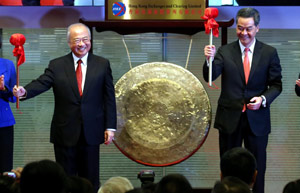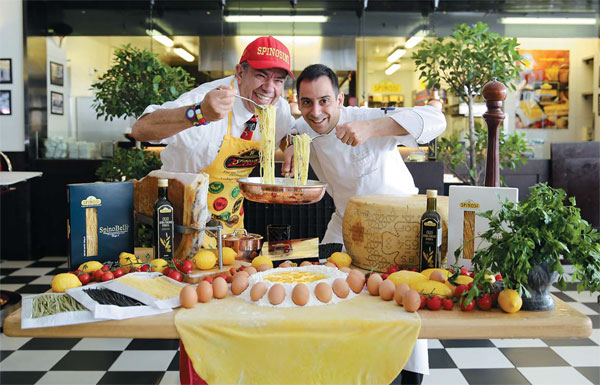Promoting Old Italian Recipes
Updated: 2014-11-24 07:03
By Dong Fangyu(China Daily USA)
|
||||||||
Acclaimed chef brings his family specialties to Chinese diners.
On a typical Thursday morning, food editors and reporters in Beijing gathered at Via Roma Italian restaurant, to see what a visiting guest dubbed the "King of Pasta" will turn out to be like.
What we've known beforehand was that he is a man who has many major titles.
|
Pasta maker Vicenzo Spinosi (left) and Francesco Sanna, head chef of Via Roma. Provided to china Daily |
Besides being hailed as the "King of Pasta" in his country, Vincenzo Spinosi also bagged the title of "Grand Official of Italy", a much honored prize for Italian citizens that is bestowed by the head of state, touted as the equivalent of the Nobel Prize in Italy.
He is also one of three Italians to receive a Five-Star Diamond Award from The American Academy of Hospitality Sciences.
When we finally meet him, we are disarmed by his comic manners and humility. The chef runs a small family business that has taken maccheroncini beyond the confines of a small village to become one of the most famous Italian products in the world.
Spinosi, based in Campofilone, in the Province of Fermo in the Italian region of Marche, is acclaimed for his pasta creations that retain the original traditions.
His pasta is not only tasty, but healthy as well, rich in Omega-3 and vitamin E.
He says the idea came from the eggs provided by a specific variety of hens called Livornesi that are fed with cereals and cold pressed sunflower oil rich in Omega 3 and vitamin E. His philosophy is to achieve the best result in the noodles by using the quality natural products.
"For the dough, only carefully selected durum wheat flour is used as well as fresh eggs still broken by hand as it has always been done in our laboratory since the very beginning."
The old recipe has been handed down unchanged.
Making the noodles is a very slow process, using bronze dies and rollers. Thus the dough is rough and porous, ready to be pulled and cut into various shapes and sections. Pasta cuts are "combed" manually on the back of a knife, and laid down on white sheets of paper folded by hand, then placed on wooden frames and left to dry for 24-36 hours at a low temperature.
The dough is prepared with the best durum wheat flour and fresh eggs, without adding any water.
Spinosi took over his father's business in 1973, and traveled around the world with a suitcase that contained a chopping board, rolling pin, eggs, and a knife, to show his family pasta.
Different from other well-known Italian pasta brands like Barilla, Nestle or Cipriani, Spinosi pasta is not usually found at supermarkets, but only at selected places such as exclusive restaurants in Italy, and a few other countries including the United States, Australia, China, Thailand and Abu Dhabi.
His company's output is small, at only 80 kilograms of noodles per hour with the help of 15 employees, he says. But Spinosi cares more about quality than quantity. "It's easier to go into large production. But you cannot have enough best-quality eggs."
Large Italian pasta brands have wanted to buy out his family business, and he could have made a lot of money. But Spinsosi decided to keep the company as a family tradition. "If you want to make something unique, you have to be unique yourself," he says.
Having traveled to cities worldwide to showcase his family brand, Spinosi believes that the Chinese culinary experience is the most exciting because "the way we make noodles is so different".
The Chinese lamian, a type of hand-pulled Chinese noodle, fascinates him.
"The first time I came to China in 2005, I was enchanted by the art of Chinese noodle making," he says. "Chinese noodle makers make noodles with their hands only, so easily, by twisting, stretching and lengthening the dough. It is amazing that one chef can make thousands of beautiful long noodles in one minute."
"It's just like an art performance, and as if by magic," Spinosi says of this traditional art of Chinese hand-pulled noodles. He suggests that the lamian should go beyond China, so more people can appreciate it, just as he has traveled worldwide to promote his Italian tradition of homemade pasta.
The first exponent of Campofilone homemade pasta was Spinosi's father, Nello Spinosi. In the 1930s, the elder Spinosi used to travel to Rome from Campofilone by horse to sell vegetables and other produce grown on his farm at markets. "At that time, there was not much money and my father brought along the maccheroncini made by my mother to pay for his accommodation in Rome", the younger Spinosi recounts.
After a while, the Roman businessmen and gourmets started to appreciate his maccheroncini, and his father started to sell it. He then created the first factory in Campofilone to produce homemade pasta in 1933.
It was considered the first such factory to feature and enhance the tradition of homemade pasta, both in Italy and worldwide.
In 2013, Spinosi's "Maccheroncini di Campofilone" got Indicazione Geografica Protetta recognition, a protected geographical indication within the European Union. The official document names Nello Spinosi as the person behind the first laboratory to produce maccheronicini.
To carry on the family tradition, the names of all the varieties of Spinosi pasta share the same semantic origins from his home.
Spinosi's signature pasta "Spinosini" was given the name used for Spinosi's kids: Spinosini! In Italian, he explains, the suffix "ni" is used for describing younger people, or babies.
Spinosi also named the "SpinoBelli" pasta, dedicating it to his now-grown sons, Marco and Riccardo. SpinoBelli pasta has a thicker section than the Spinosini. In 2012, Vincenzo Spinosi created a new product "Spinosina", this time named for his first granddaughter, Emma.
On Sundays, he likes to make Italian dumplings, called gnocchi, at his home in Campofilone.
"Sunday is the day of the family gathering", he says.
dongfangyu@chinadaily.com.cn
(China Daily USA 11/24/2014 page10)

 Sports moments of the week: Nov 17-23
Sports moments of the week: Nov 17-23
 42nd American Music Awards held in Los Angeles
42nd American Music Awards held in Los Angeles
 A retrospection of righted wrongs
A retrospection of righted wrongs
 Top 10 kinds of foreigners in China
Top 10 kinds of foreigners in China
 Anxious Ferguson waits for grand jury's decision
Anxious Ferguson waits for grand jury's decision
 Mascots from Olympic, Paralympic games arrive in Rio
Mascots from Olympic, Paralympic games arrive in Rio
 China's boxer Zou Shiming defeats unbeaten Thai
China's boxer Zou Shiming defeats unbeaten Thai
 Mountains echo to the sound of music
Mountains echo to the sound of music
Most Viewed
Editor's Picks

|

|

|

|

|

|
Today's Top News
US aids in return of economic fugitives
80% of China's rich aspire to overseas education
International luxury hotels expand in China
Disney, SMG expand partnership
LA mayor visits Beijing
Subway-push victim mourned in Chinatown
China, Pacific island nations boost ties
Media reveals aircraft carrier base spying case
US Weekly

|

|








